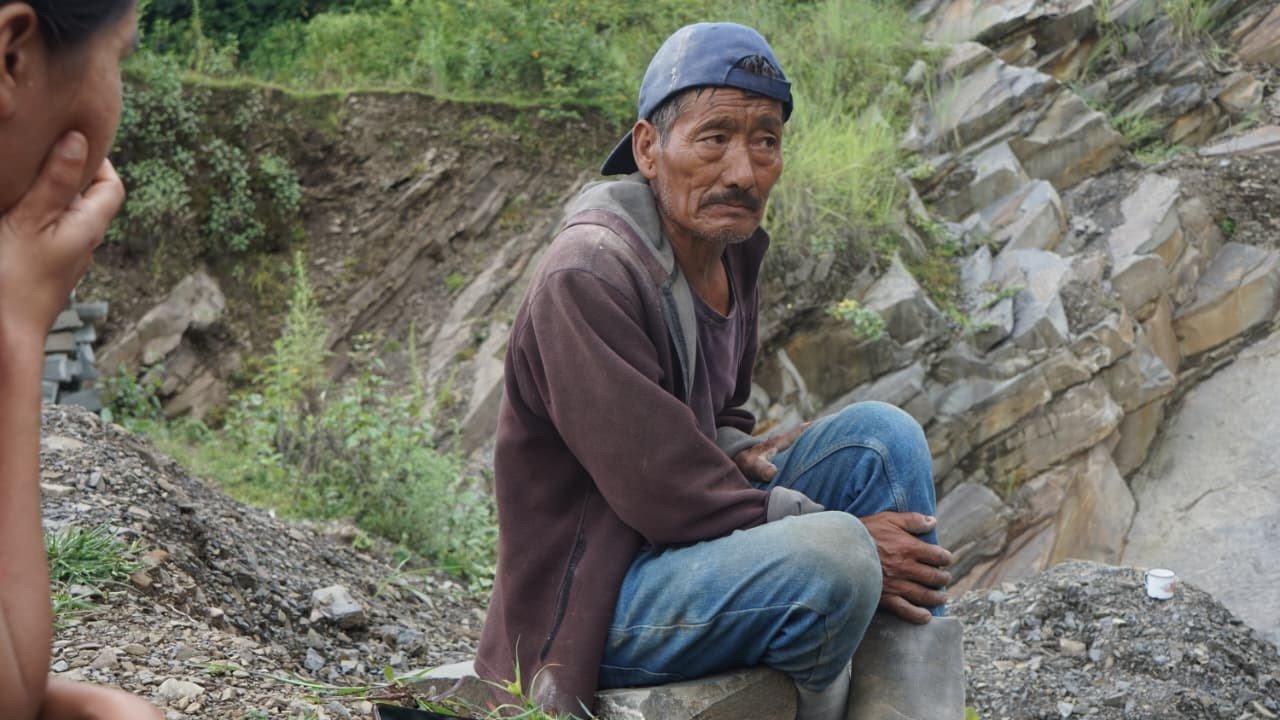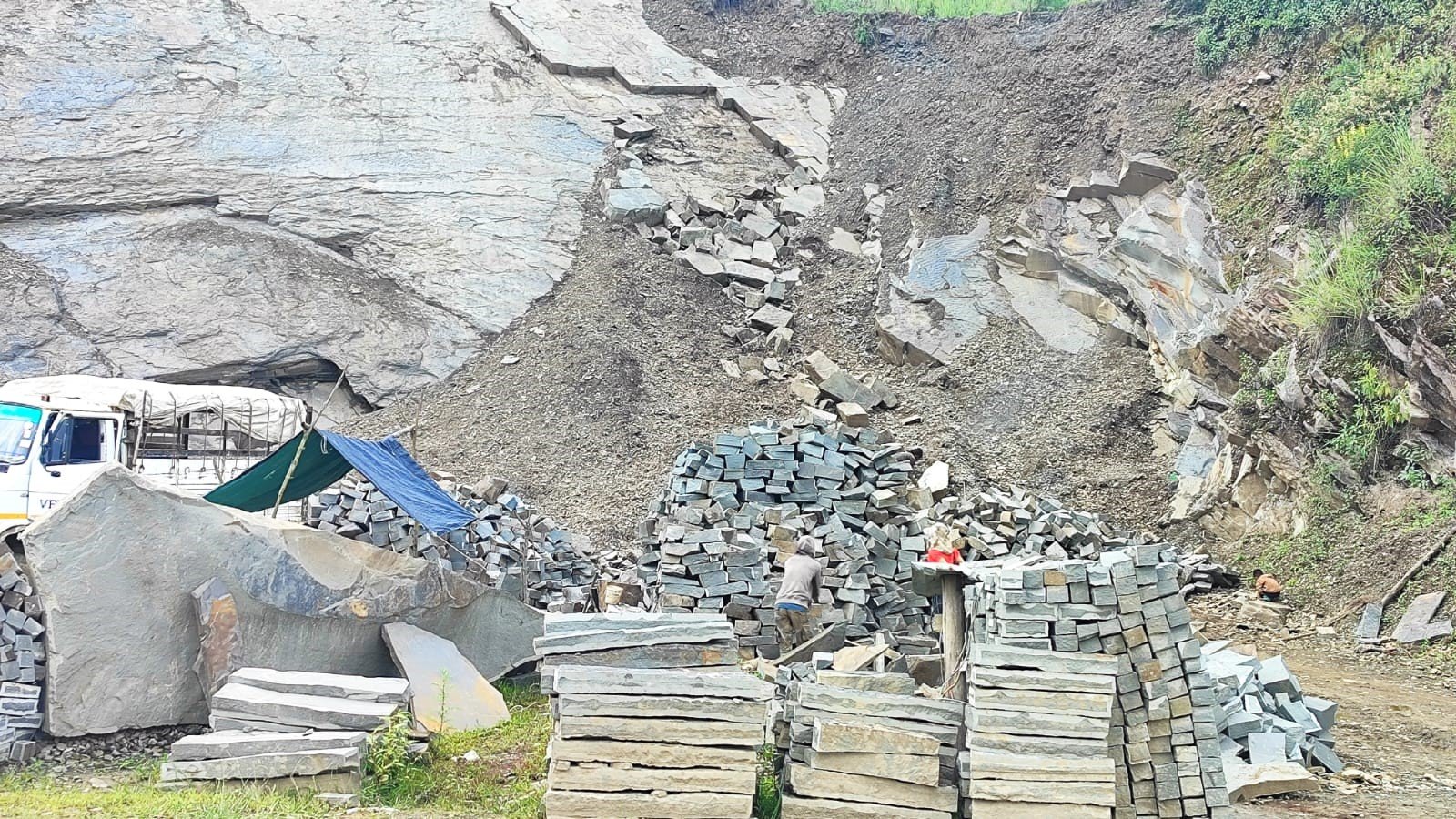In the dusty yards of Kuthur village in Shamator district, the sounds of hammer against stone echo throughout the day, telling the story of a livelihood for 50 years now. Chisels spark as they strike, and clouds of fine dust rise, only to settle on the workers who spend cutting the stone under the sun.
Here, giant stones are given a second life—cut, shaped, and prepared to become walls, foundations, and homes. What began as the solitary labour of one man the 1975s has grown into the heartbeat of a community. Today, stone cutting is not only a livelihood but also a cultural identity for the people of Kuthur.
A Legacy Carved in Stone
This story began with Sashi, a man remembered fondly by the people of Kuthur. With a little more than determination and a pair of hammers, Sashi first took up stone cutting in the mid 1970s. In those days, it was not seen as a profession, nor was it considered a skilful trade, but a simple manual labour.
60 years-old Wongchuba, then in his early twenties recalls those days vividly saying that he and his friends would watch Sashi toil the stone. “We didn’t know how to cut,” he says. “We just watched him, and that’s how we learnt. We used only hammers back then”, Wongchuba recalls how they simply began cutting and breaking the stones.
From those early experiments, an industry was born. What started as one man’s initiative slowly became a community pursuit, providing sustenance for families and shaping the economic backbone of Kuthur village.
The 60-year-old says that time have changed- earlier, it used to be only a hammer and chisel, but now machines have made work easier and faster.

Memories of an Era
Wongchuba recalls his younger days, when the stone yard was as much a place of learning as it was of laughter. Friends worked side by side, sweating under the sun, exchanging jokes between the ringing strikes of metal on rock. But with time, many of his companions have passed on, leaving behind memories and legacy of their workmanship scattered in the village.
Today, Wongchuba, despite his age, continues to cut stone not merely for income but to keep himself fit and connected to the work that shaped his life. “I’m happy to do it and will continue to do it,” he says.
Download Nagaland Tribune app on Google Play

From Labour to Livelihood
Over the decades, stone cutting has transformed from an experiment into an art, and from mere labour into a livelihood. The villagers have never undergone formal training, instead, skill was sharpened through daily practice and observation. Slowly, they have become craftsmen in their own right.
For the people of Kuthur, stone cutting is no longer just about shaping rocks. It is about shaping lives. The income earned through this trade sustains families, sends children to school, and keeps the community thriving. In a region where opportunities for formal employment are limited, stone cutting has become a reliable source of survival.
“Every household here is connected to stone cutting in one way or another,” says a local villager. “It is not just work—it is who we are,” he says.

A Risk Without Safety
Yet, the work is not without dangers. Giant rocks are cut directly from cliffs, often with bare hands and simple tools. There are no helmets, gloves, or safety kits. One misstep or falling stone could mean injury—or worse. But necessity outweighs risk, and the villagers continue their daily battle with the rocks. Fortunately, no tragic accidents were said to have occurred until this day.
“It is dangerous, yes, but what choice do we have? This is how we live,” one cutter admits.
The absence of safety equipment highlights the vulnerability of those who depend on this occupation. However, the stone cutters remain resilient, trusting their skills.
The Women Behind the Work: the heroines of the yard
While men cut the rocks from the cliffs to shaping into fine stones and bricks, the women of Kuthur play an equally vital role. Day after day, they sit with hammers, breaking the heavy boulders into smaller blocks. The painstaking work demands enormous amount of patience. The women sit under temporary shades breaking the stones piece by piece. Piled-up small mountains of stone blocks beside them ready to be sold.

A female stonemason said the gloves they wear to protect their hands do not last even a day, and sometimes, the hammer hits their hands and the pain is unbearable.
Many women have spent 10 to 15 years in the stone yard, their hands roughened by years of gripping iron tools. These are the unsung heroines of Kuthur. Their earnings supplement household incomes, enabling families to run smoothly. For the Kuthur women, it is not just about sitting a long day breaking stones, but while doing so, the moment becomes a time of sharing one’s own stories of struggles and challenges, a time of emotional support from each other.
“We are supporting our men in this,” one woman shared. “Together, we make it work,” she said.
These women embody the quiet strength of Kuthur, proving that livelihood is not only a man’s responsibility but a shared effort.

Youth and Community Involvement
In recent years, stonemasonry has also offered opportunities for unemployed youth. For young men and women without access to formal jobs, the stone yard provides both income and purpose. While the work is laborious, it ensures that no one in the village goes hungry.
Beyond individual sustenance, stone cutting has become a tool for collective growth. Student unions, church organizations and clubs often use this as a fundraising mechanism. Large piles of rocks are cut and sold to generate money for educational, social, and religious purposes. In this way, the stone yard supports not only households but also the broader community.

More Than Just Stones
Walking through Kuthur’s stone yards, one realizes that these are not just places of labour. They are spaces where stories are shared, where traditions are passed down, and where hardwork and determination is forged. Each chisel mark on the rocks represents not just human effort but also the continuity of a culture built on determination.
Stone cutting in Kuthur is both a livelihood and a legacy. It is a reminder of the past—of Sashi’s lone hammering in 1975—and a promise for the future, as the younger generation picks up the tools of their elders.
Kuthur’s stone cutting business has opened a path to livelihood to many youths who are willing to learn and work, as said by one cutter. The final outcome of fine stones are exported to places mainly Noklak, Tuensang, Kiphire, Mokokchung and other places.

The Road Ahead
As Kuthur marks decades of stone cutting, questions remain about the sustainability of this livelihood. The risks, the lack of safety equipment or health insurance, and the heavy physical demands make it a difficult trade. Yet, for now, they remain committed.
Standing in the yard, listening to the unending clinks of hammer and chisel against rocks, one cannot help but feel the pulse of Kuthur. The Stone Cutting yard has become the heartbeat of the people of Kuthur.
– This is the first of a four-part series of reports on the construction sector in Nagaland written as part of the Kohima Press Club-Nagaland Building and Other Construction Workers Welfare Board (KPC-NBOCWWB) Media Fellowship 2025

